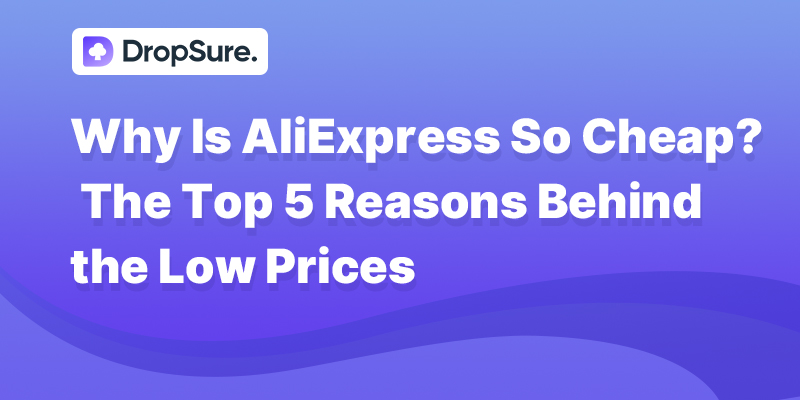If you own an online dropshipping store, then pricing strategy is definitely an aspect you need to take seriously. When pricing your products, you can’t just rely on your gut feeling. You have to take into account various expenses such as product costs, marketing costs, taxes, hosting fees, app fees, and even psychological factors.
Don’t worry. In this guide, you’ll learn what dropshipping pricing strategy is, how to choose the best retail price, the different pricing strategies you can use, how to adjust product prices reasonably, and more!
So, if you’re asking yourself, “What retail price should I set for my products?” then this article is for you.
Let’s get started!
What is Pricing Strategy
When it comes to pricing strategy, you might think it sounds like a complex business term, but it’s as simple as setting a price for your favorite perfume. It’s about finding that sweet spot where you can earn a profit while ensuring customers feel they’re getting great value.
In short, a pricing strategy is the method by which a business sets reasonable prices by studying market demand, product costs, competitors, and other factors. Sounds a bit like giving yourself a “price checkup”? That’s right—a pricing strategy helps you find the most appropriate “healthy price” that lets you profit without scaring away customers.
Why Do You Need a Pricing Strategy
You might think, “Isn’t it just about setting a price? What’s so special about it?” In reality, pricing isn’t that simple. An appropriate pricing strategy can help you attract potential customers and increase your profits.
Imagine if you set the price too high, customers might feel it’s too expensive and walk away; but if you set it too low, you might feel you’re not making enough money and end up feeling like you’re “underselling.” Therefore, a good pricing strategy can help you strike this balance, making your products attractive to customers without sacrificing your profit margins.
Main Types of Pricing Strategies
Alright, let’s cut to the chase and discuss some common types of pricing strategies. You can choose different pricing methods for different products, just like selecting outfits for various occasions.
Price Skimming: This is like an “early access version,” where you set the price high initially to earn a quick profit, then gradually lower it as more customers line up to purchase.
Penetration Pricing: Similar to a clearance sale, you set the price low from the start to attract a large number of customers quickly, thereby rapidly gaining market share.
Competitive Pricing: This involves closely monitoring your competitors’ prices and setting a similar price to maintain competitiveness.
Value-Based Pricing: Think of it as the “you’re worth it” approach, where you emphasize the unique value of your product and set a higher price to attract customers willing to pay for that value.
How to Set the Best Price for Products in a Dropshipping Store
Calculate Costs to Ensure Profitability
Product Cost: This includes the supplier’s price plus shipping fees.
Marketing Expenses: Costs associated with advertising and promotions.
Transaction Fees: Fees for payment processing and platform commissions.
Operational Costs: Expenses such as Shopify subscriptions and software fees.
Profit Margin: Aim for a profit margin of at least 30-50%.
Formula:
Selling Price = Product Cost + Desired Profit + Other Expenses
Market Pricing Analysis
To set the optimal price for your dropshipping store’s products, it’s essential to conduct a thorough market pricing analysis. This involves understanding your competitors’ pricing strategies, identifying your target market, and positioning your products accordingly.
Understand Competitors’ Pricing Strategies
Begin by researching how competitors price similar products. Some may adopt a premium pricing approach, targeting high-end consumers, while others might opt for a low-price strategy to attract budget-conscious shoppers. Recognizing these patterns helps you identify the pricing range within the market and determine where your products can fit in.
Identify Your Target Market
Understanding your target market is crucial. Consumers’ purchasing power and preferences vary across different regions and demographics. Determine who your ideal customers are and how much they’re willing to pay for your products. For instance, premium-priced products often appeal to quality-focused customers, whereas lower-priced items may attract those seeking value for money.
Position Your Products
Your product’s positioning directly influences your pricing strategy. If your products boast unique designs, superior packaging, or offer additional services, consider adopting a premium pricing model. This approach appeals to customers willing to pay more for perceived value.
Conversely, if your products are impulse buys, a lower pricing strategy might be more effective, provided you can maintain profitability through cost control.
By integrating these factors—competitor pricing, target market analysis, and product positioning—you can establish a competitive and appealing price point for your dropshipping products. Remember, pricing isn’t static; regularly reviewing and adjusting your prices in response to market changes ensures sustained competitiveness.
Psychological Pricing Strategies
Pricing strategies can significantly influence customer perceptions and purchasing decisions. Here are some common psychological pricing techniques:
Charm Pricing: Setting prices ending in .99 or .95 (e.g., $19.99 instead of $20.00) can make products appear more affordable, as customers often perceive these prices as being lower than they actually are.
Prestige Pricing: For high-end products, using round numbers (e.g., $50.00) can convey quality and professionalism, aligning with a premium brand image.
Anchoring with Original Prices: Displaying the original price alongside a discounted price (e.g., “Was $59.99, now $39.99”) can create a perception of value, making customers feel they’re getting a great deal.
Bundle Pricing: Offering multiple products at a combined price (e.g., one item for $20, or two for $35) can encourage customers to purchase more, perceiving greater value in the bundle.
Testing & Adjusting
After setting initial prices for your dropshipping store, it’s crucial to engage in continuous testing and adjustments to optimize profitability and competitiveness. Here’s how you can approach this:
A/B Testing
Implement A/B testing to evaluate different pricing strategies. By presenting variations of a product at different price points to separate segments of your audience, you can analyze which price yields better sales and conversion rates. This method provides empirical data on customer preferences and price sensitivity, enabling informed pricing decisions.
Dynamic Pricing
Adopting dynamic pricing allows you to adjust prices in real-time based on various factors such as advertising costs, seasonal demand, and market conditions. For instance, during holiday promotions, you might lower prices to attract more customers, while increasing prices during peak demand periods can maximize profits. This flexible approach ensures your pricing remains competitive and aligned with market dynamics.
Regular Profit Analysis
Consistently monitoring your profit margins is essential. Utilize tools like Shopify plugins or Google Sheets to track and analyze the cost and revenue of each product. This practice ensures that your pricing strategies are yielding the desired profitability and allows for timely adjustments to prevent potential losses.
By integrating continuous testing and dynamic adjustments into your pricing strategy, you can maintain a competitive edge and ensure sustained profitability in your dropshipping business.
High-Profit Upselling
High-profit upselling boosts sales and improves customer experience. For example, when a customer buys a phone case, suggesting a tempered glass screen protector can complete their purchase and increase order value.
Offering add-ons like membership subscriptions, extended warranties, or personalized services can also raise perceived product value and build customer loyalty.
Low-Priced Products ($0-$10) Pricing Strategy
Low-priced products between $0 and $10 often attract impulse buyers. When browsing, customers are quick to purchase because of the attractive prices. You can stimulate sales by offering small discounts or limited-time promotions. Although the profit per order may be low, volume can add up to substantial revenue. Additionally, low-priced products require careful cost management, ensuring every penny is well spent.
Mid-Priced Products ($10-$100) Pricing Strategy
For mid-priced products, you must offer a fair price while clearly demonstrating the quality and value of the product. Detailed product descriptions, clear images, and customer reviews can help ease any concerns, making customers feel that the price is absolutely worth it. The key is to strike a balance so that customers perceive not only a reasonable price but also an overall satisfying experience with both the product and service.
High-Priced Products ($100 and Above) Pricing Strategy
For high-priced products, customers tend to value quality, uniqueness, and after-sales service. Emphasize the product’s unique design and superior quality, and consider offering value-added services such as extended warranties or personalized customization. While high-priced products may not sell as frequently as low-priced items, each transaction yields higher profits and helps build a premium brand image. As long as customers feel they are receiving an exclusive experience, they will see the investment as worthwhile.
How can you leverage DropSure?
With DropSure, merchants can eliminate the hassle of inventory and shipping, allowing you to focus more on marketing and expanding your customer base. Whether you’re just starting out or already running a large-scale business, DropSure offers tailored services to help you stand out in a fiercely competitive market.
If you’d like to learn more or start using DropSure, please contact our customer support team for further details and begin elevating your e-commerce business.
Conclusion
In summary, setting the best price for your dropshipping store requires precise cost calculations, a deep understanding of the market and target customers, and the use of psychological pricing strategies with continuous testing and adjustments.
This can be summarized in the following points:
| Core Strategy | Implementation & Description |
|---|---|
| Accurate Cost Calculation | Cost Components: Product cost, shipping fees, platform fees, marketing expenses. Profit Benchmark: Set profit margin at 50%-100%. |
| Market & Customer Analysis | Competitor Research: Analyze mainstream pricing ranges for similar products. Customer Segmentation: Use social media surveys or purchase data to assess price sensitivity. |
| Psychological Pricing Strategy | Low-Priced Products: Use X.99 pricing to trigger immediate purchase decisions. Mid-to-High Priced Products: Use round number pricing with service guarantees. |
| Dynamic Testing & Optimization | A/B Testing: Test two price points for the same product to compare sales and profits. Periodic Adjustments: Increase prices 5%-10% during peak seasons; tiered discounts for slow sellers. Tool Assistance: Use tools to monitor competitors’ price changes and auto-sync fluctuations. |
Whether it’s low-priced products attracting impulse buys or mid-to-high priced items showcasing quality and service, as long as you understand consumer needs, you can maximize profits.

 11 min read
11 min read




